Review by Mike Barrett
Leadtek have a very strong presence in the PC market, and have been around in the GPS industry for some time now. Indeed they made the original wired and wireless GPS receivers for TomTom way back when PDA navigation was pretty much the only alternative to an expensive in-car Satnav system.
Last year Leadtek released the stylish 9553, and now have followed it up with another slim, stylish Bluetooth GPS receiver powered by a SiRFStarIII GPS chipset. With a street price of around £65 is this a GPS that lives up to the reputation of the previous GPS hardware? Read on to find out what we thought...
|
 |
Leadtek 9559X Bluetooth GPS receiver product specifications
The following are the official 9559X GPS receiver specifications have been reproduced from the Leadtek website:
Chipset GSW3 SiRFStarIII technology
General Frequency L1, 1575.42 MHz
C/A code 1.023 MHz chip rate
Channels 20
Accuracy Position 10 meters, 2D RMS
5 meters 2D RMS, WAAS corrected
<5meters(50%), DGPS corrected
Velocity 0.1 meters/second
Time 1 microsecond synchronized to GPS time
Datum Default WGS-84
Time to First Fix(TTFF) Reacquisition 0.1 sec., average
Hot start 1 sec., average typical TTFF
Warm start 38 sec., average typical TTFF
Cold start 42 sec., average typical TTFF
Dynamic Conditions Altitude 18,000 meters (60,000 feet) max.
Velocity 515 meters/second (1000 knots) max.
Acceleration 4g , max.
Power Main power input 5±5%(10%) V DC input
Power consumption ≈390 mW (continuous mode)
Backup Power 1.5±10% V DC input
Time-1PPS Pulse Level 3.3V TTL
Pulse duration 1 µs
Time reference At the pulse positive edge.
Measurement Aligned to GPS second, ± 1 microsecond
Interface Specifications Power Recharge Mini-USB connector
Connector for External Antenna MMCX
Bluetooth specifications Frequency 2400MHz to 2483.5MHz
Modulation Method GFSK, 1Mbps, 0.5BT Gaussian
Maximum Data Rate Asynchronous: 723.2kbps/57.6kbps Synchronous: 433.9kbps/433.9kbps
Transmission Power (Maximum) 4dBm(Class 2)
Hoping 1600hops/sec, 1MHz channel space
Receiving Signal Range -84 to -15dBm
Receiver IF Frequency 1.5MHz center frequency
Baseband Crystal OSC 16MHz
Compliant Bluetooth Specification v 1.2
Profile Series Port Profile (SPP)
Bluetooth Operation Range 10 M
Electrical Specifications Main power input 5±5%(10%) V DC input
Power consumption ≈390 mW (continuous mode)
Backup Power 1.5±10% V DC input
Operation Time 11 hours (1000mAh Li-Ion battery)
Battery Electrical Battery Cell Li-ion (1000mA)
Output Voltage 2.3V~4.2V ±0.025V
Dimension (LxWxH) 2.09” x 1.34”x 0.25”
Environmental Characteristics Operating temperature range -10 deg. C to +50deg. C
Storage temperature range -20 deg. C to +65 deg. C
Physical Characteristics Length 68.1mm ( 2.68 in)
Width 44 mm ( 1.73 in)
Height 26.5 mm ( 1.04 in)
Weight 70 g (including rechargeable battery)
Software Specifications Core of firmware SiRF GSW3
Baud rate 19200 bps (dual chipset) 38400 bps (single chip)
Code type NMEA-0183 ASCII
Datum WGS 84 default (User configurable)
Protocol message GGA(1sec), GSA(5sec), GSV(5sec), RMC(1sec),VTG(1sec)
Output frequency 1 Hz |
|
The Leadtek 9559X Bluetooth GPS review
Each year Leadtek release a new GPS receiver. This year it the 9559X Bluetooth GPS receiver: a slim and stylish device.
Built around the most sensitive to date of the SiRF GPS chipsets: the SiRFStarIII this receiver has both low power requirements and high sensitivity. But not only that it has had a good deal of thought put into the package to get an ideal balance of style and functionality.
The tri-colour casing not only looks good, but is also very durable and has stood up to a fair amount of traveling and abuse over the last few months with no scratches or blemishes. |
 |
Taking a tour around the outside we have a pair of indicator LED's at the top. A blue one that flashes when there is no Bluetooth connection, or solid when a device is communicating with it. Beside it is a green GPS indicator which is solid when acquiring a GPS fix and flashing when navigating. I found the LED's to be somewhat too bright, particularly at night time when they were a little distracting.
On the side of the GPS is a sliding on-off switch. I am a great believer in the use of a physical power switch rather than an on switch and an auto power off function. I do understand that some users prefer the auto power to turn the system off when the Bluetooth connection is lost. |
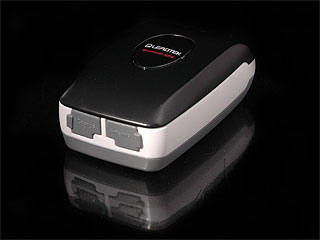 |
On the bottom of the Leadtek 9559x there are two rubber covers protecting external connections to the GPS receiver.
The one to the right conceals a connector for an external antenna. This has a MMCX style connector. I am not entirely convinced of the requirement for an external antenna as the GPS receiver can be positioned up to 10 metres away from the PDA/Phone it is connected to.
This is of course useful if you want to hardwire the GPS in the car in a concealed location. The antenna can then be placed to receiver an optimal signal while the GPS is hidden away in the glove box or another potentially shielded location. |
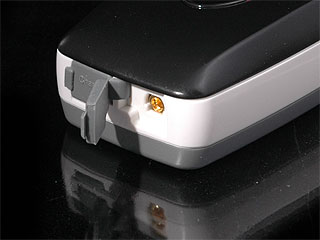 |
The other flap hides the power connector. This is a standard mini-USB connector. One of the best developments in this last year is a move by manufacturers standardising on mini-USB powering.
I like the concept of the mini-USB as it allows for a wide range of power options. You can use a mains to mini-USB, cigar lighter to mini-USB, or PC to mini-USB. This gives me the flexibility to reduce the number of adapters I take with me whilst traveling. My worst nightmare is taking a charger for each electronic device I use, and leaving a critical one at home. Having one power charger for most of my devices is great especially if it is a flexible one like the mini-USB. |
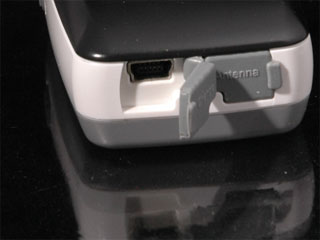 |
Whilst on the subject of power... The Leadtek 9559x has a 1000mAh rechargeable, replaceable, Li-ion battery which is compatible with the Nokia 3650 power source.
Having a replaceable standard and easy to obtain battery has two advantages. Firstly if you need a second or replacement battery they will be easy to source from third party vendors. Secondly because of the popularity of the battery it will be cost effective. I don't know why all manufacturers don't use commonly available batteries.
There are no markings on the supplied battery to confirm the capacity, but it performs close to the specified 11 hours...
|
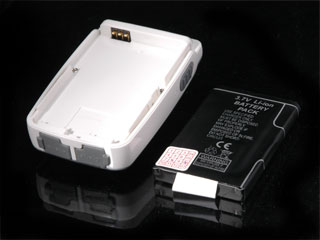 |
Whilst the battery cover is off you can attach a lanyard to the GPS by slipping it over the raised lug prior to shutting the casing.
That just about wraps up our look at the exterior of the Leadtek 9559x. The internals of the device have all the usual SiRFStarIII components featuring SBAS or enhanced GPS location technology giving a potential accuracy of 5 metres.
The time to get a fix so you can start navigating ranges from 1 sec (hot start) to 48 seconds (cold start). These timings can be extended in less than perfect conditions. |
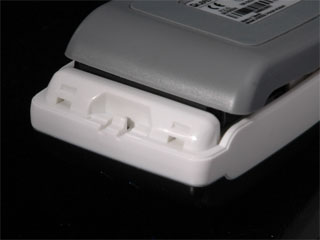 |
The Leadtek 9559X BT GPS in use.
So the Leadtek 9559x sounds good and looks good, but how does it perform in real life? Where better to test this than in the Urban Canyons of Sydney, the dense foliage of the Queensland rain forest, and the open seas of the Great Barrier Reef?
The first thing to do of course is to pair the GPS with a PDA. I was testing with 2 different PDAs, an O2 XDA Exec, and an Orange M500. Using the Passkey '0000' the devices were connected and serial ports assigned.
In both cases the GPS was quick to fix and worked with no problems in the applications I tried it with TomTom and Memory-Map.
|
 |
I did experience some pairing problems with the GPS and the O2 XDA Exec. Although the pairing and assigning of serial ports seemed to work properly, and indeed the navigation applications worked correctly. After switching the GPS and PDA off and trying to restart later the Leadtek asked to re-pair with the Exec. It appeared as if the pairing had only half worked.
I have since acquired a HTC 3300 with WM5.0 and found that the same problem exists. I can therefore only assume that there are issues with WM5 compatibility and the Leadtek 9559x.
My 9559X connected and paired correctly with both the M500 and a Nokia N80 mobile phone. |
 |
Conclusion
The Leadtek 9559X is a very capable GPS device. With today's technology it is getting more and more difficult to separate devices based on functionality. The differentiation needs to take place based on price, style and power. The Leadtek scores well in all three areas. The only issue found whilst testing was the pairing problems I found with WM5 devices. |